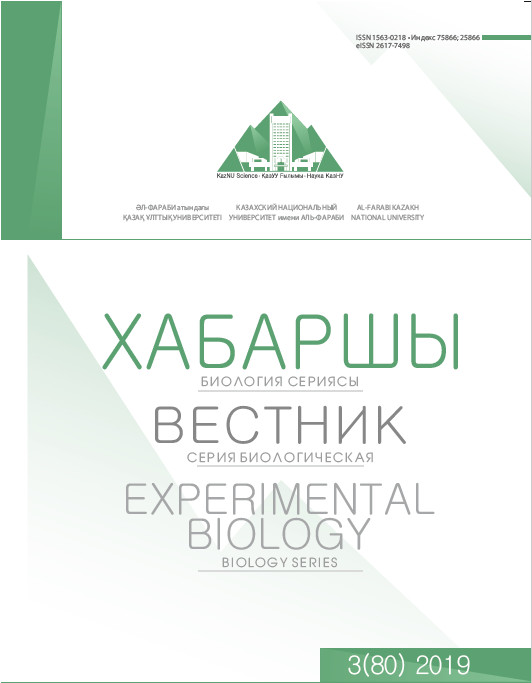Determination of biochemical changes in the blood and lymph after poisoning zinc salts animals
DOI:
https://doi.org/10.26577/eb-2019-3-b17Abstract
This article studies the cellular and biochemical parameters of rat lymph after exposure to zinc sulfate. It was found that an increase in hemoglobin concentration by 12.61% after administration of zinc salts is an indicator of the development of relative erythrocytosis and chronic hypoxia. After the administration of zinc salts in rats, there is an increase in osmotic pressure in the lymph, as well as the overall level of proteins in the lymph is reduced by 19%. Zinc salts also reduce proteolytic activity in lymph, proteins, lymph nodes, liver, intestinal wall. The decrease in the total amount of protein after poisoning by 32.03% informs about the decrease in protein transportation to the blood system and lymphatic system, as well as about the decrease in the activity of reduction of lymphatic vessels and nodes. As a result of biochemical studies, it was found that lymph is subject to changes in cellular and biochemical parameters that accumulate in individual organs and cause significant changes in the function of a single organism. In case of poisoning, there was an increase in the content of alkaline phosphotase to 22-65%, as well as an increase in the level of aminotransferase enzymes, which indicates a violation of liver function, an increase in liver cytological processes, a decrease in protein synthesis and a violation of metabolic transport. After poisoning rats with zinc salts, there is an increase in the size of the cervical and spotty lymph nodes. There is a slowdown of the lymphatic channel in the lymphatic vessels, a decrease after poisoning by 21.2%. The data obtained made it possible to form a set of data on the negative impact of zinc salts on the body and can serve as a scientific basis for the solution.
Keywords: hemoglobin, rats, lymph, lymphatic flow, zinc sulfate, erythrocyte.
References
2. Abdreshov S.N. Ecological human physiology. Tutorial. - Almaty, “Economy”, - 2009, -224 p.
3. Tuleukhanov S.T., Baktybaeva L.K., Svambaev E.A., Gumarova L.Zh. Immune indices of peripheral blood of rats and bone marrow of mice when intoxicated with salts of heavy metals // IV Congress of CIS countries fortifiers. Moscow State Institute of Steel and Alloys (Technological University) March 28 - 30, 2007. Collection of materials. Vol. 1, pp. 229–231.
4. Sidarenko G.I., Mozhaev E.A. Environmental health and public health. / M .: Medicine, 1987- S. 128.
5. Dumbrava, V.A., Tsurkan, SI, Lupashko, Yu.A., Moskalu, Yu.V., Gelmich, TE Immune status indicators as a criterion for assessing the environmental situation // Perspective information technologies and problems of risk management on the threshold of a new millennium: Materials of the International Ecological Symposium. - St. Petersburg, 2000. - p. 243-246.
6. Kharkevich D.A. Pharmacology. textbook for universities. / M.: GEOTAR-MED, 2002. C. - 125–136.
7. Mazo V.K., Gmoshinsky I.V., Skalny A.V. et al. Zinc in human nutrition: physiological needs and bioavailability // Nutrition Issues, 2002. –T. 71, No. 3. -WITH. 46–51.
8. Khaitov R.M., Pinegin B.V. Immunomodulators: mechanism of action and clinical application. // Immunology, 2003. - №4, p. 196–203.
9. Stoltzfus R.J. New evidence of interplay of iron and zinc at the enterocyte and neural tissues // J. Nutr. 2004. - 134: 6 - P. 1295–8.
10. Solomons N.W., Cousins R.J. Zinc In Solomons N.W., Rosenberg I.H. (eds). Absorption and malabsorption of mineral nutrients. // Alan R Liss. New York, 2004. p. 125–197.
11. Peres JM, Bureau F., Neuville D., Arhan P., Bougle D. It depends on their ratio // J Trace Elem Med Biol, - 2001. - No. 15: 4. - R. 237–41.
12. Olivares M., Pizarro F., Ruz M. New insights about iron bioavailability inhibition by zinc // Nutrition, - 2007. - No. 23: 4. - R.292–5.
13. Olivares M., Pizarro F., Ruz M. Zinc inhibits nonheme iron bioavailability in humans // Biol Trace Elem Res. - 2007, - Vol.117, №1–3. - R. 7–14.
14. Banner K.N., Page S.P. P. Immunomodulatory actions of xanthines and isoenzyme selective phosphodiesterase inhibitors // Monaldi Arch. Chest. Dis. - 1995. –V. 50. - p. 286–292.
15. Abdreshov S.N., Satpayeva Kh.K., Akhmetbaeva N.A., Koibasova L.U. Method of correction of changes in the lymphatic system in case of poisoning with heavy metals // Sb. mes. international Symposium "Physiology and Pathology of the Lymphatic System", - Almaty, 2006, - P.17-18.
16. Cheredeev A.I. Study of spontaneous rosette-forming cells of human peripheral blood // Lab. business, 1976. - №6. - pp. 350–354.




